Five Great Underwater Photography Sites Around Vancouver Island
Canada’s western-most province is a treasure trove for camera carrying divers. Point just about anywhere to shoot pretty much everything. Swift currents and abundant nutrients nourish spectacular marine life in the jade-green world beneath BC’s waterline. The photo opps around Vancouver Island are virtually limitless: reefs and wrecks, wide angle and macro, celebrity species and obscure beasties. There’s so much vying for your lens time. To warm up your trigger finger in these cool waters let’s survey five dive sites that help begin to paint a picture of the creative spectrum of marine life and scenery that make diving and underwater imaging in British Columbia so special.
Rock of Life, Queen Charlotte Strait
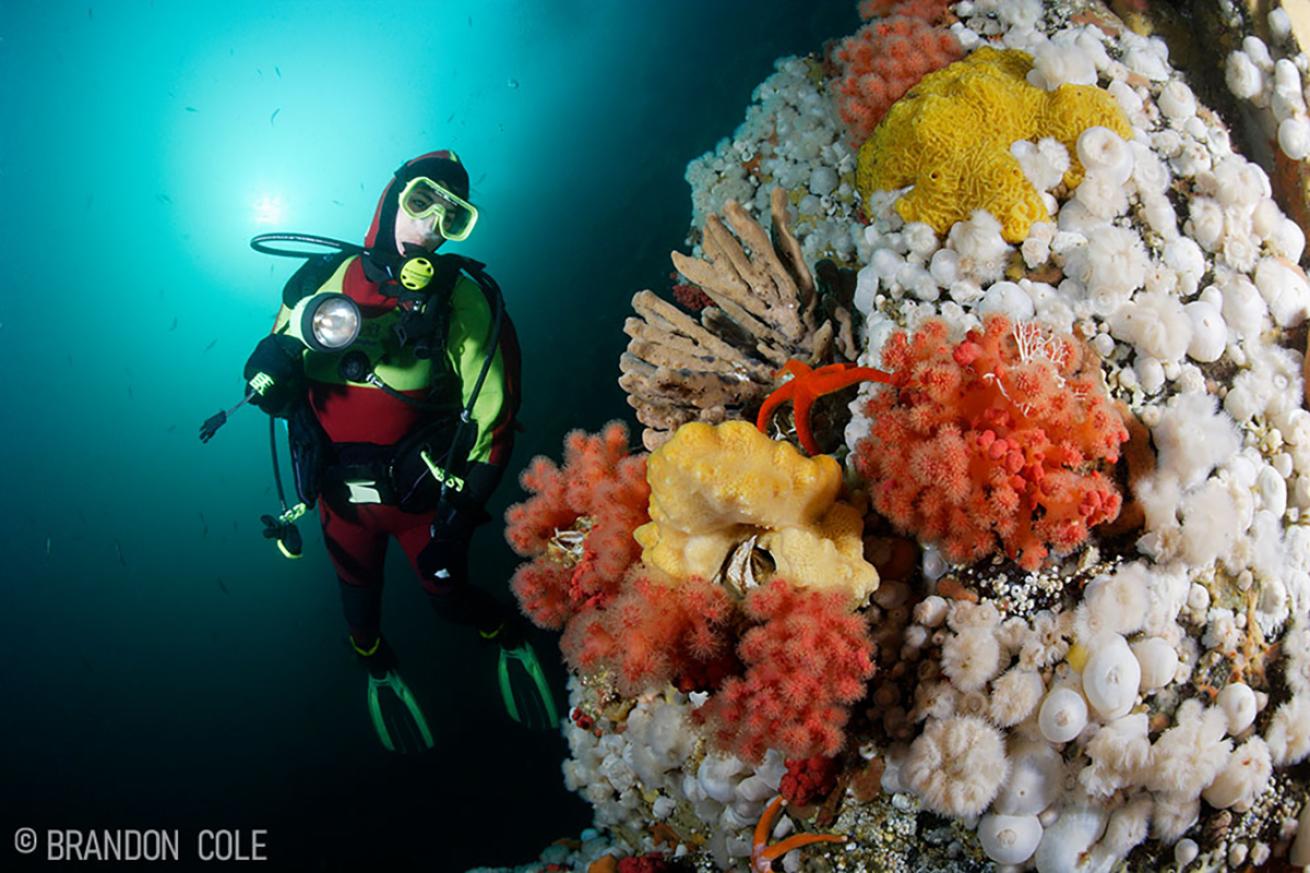
Brandon ColeThe soft corals of British Columba entrance a diver.
Many of BC’s top dives are scattered throughout Queen Charlotte Strait off the inside, northeastern corner of Vancouver Island. Browning Passage gets much of the focus, with good reason, and a personal fave for photography of all stripes is Rock of Life, aka Snowball, aka Buttertart. All names translate into “Awesome.” Wide angle is a no-brainer here, as the wall explodes with the tropically bright colors of a cornucopia of densely-packed invertebrate life including raspberry soft corals, yellow sulfur sponges, and white plumose anemones. Add basket stars, sea stars, giant orange peel nudibranchs, red urchins, glove sponges, and clusters of barnacles and you have a multi-layered living tapestry perfect as a backdrop for sweeping panoramas and diver shots.
Strong currents race along the wall, so your boat will need to stay live and time your drop for slack water—the window between flood and ebb tidal exchanges when water movement is at a minimum—so you can safely and effectively get your photo game on. I find that depths between 60 and 80 feet are most productive for the compelling, kaleidoscopic big picture visuals. If ambient light levels are too low or visibility poor due to a plankton bloom, fear not; macro opportunities are magnificent. Think red Irish lords, decorated warbonnets, tiny sea spiders and sea fleas, decorator crabs, and so much more.
Ogden Point Breakwater, Victoria
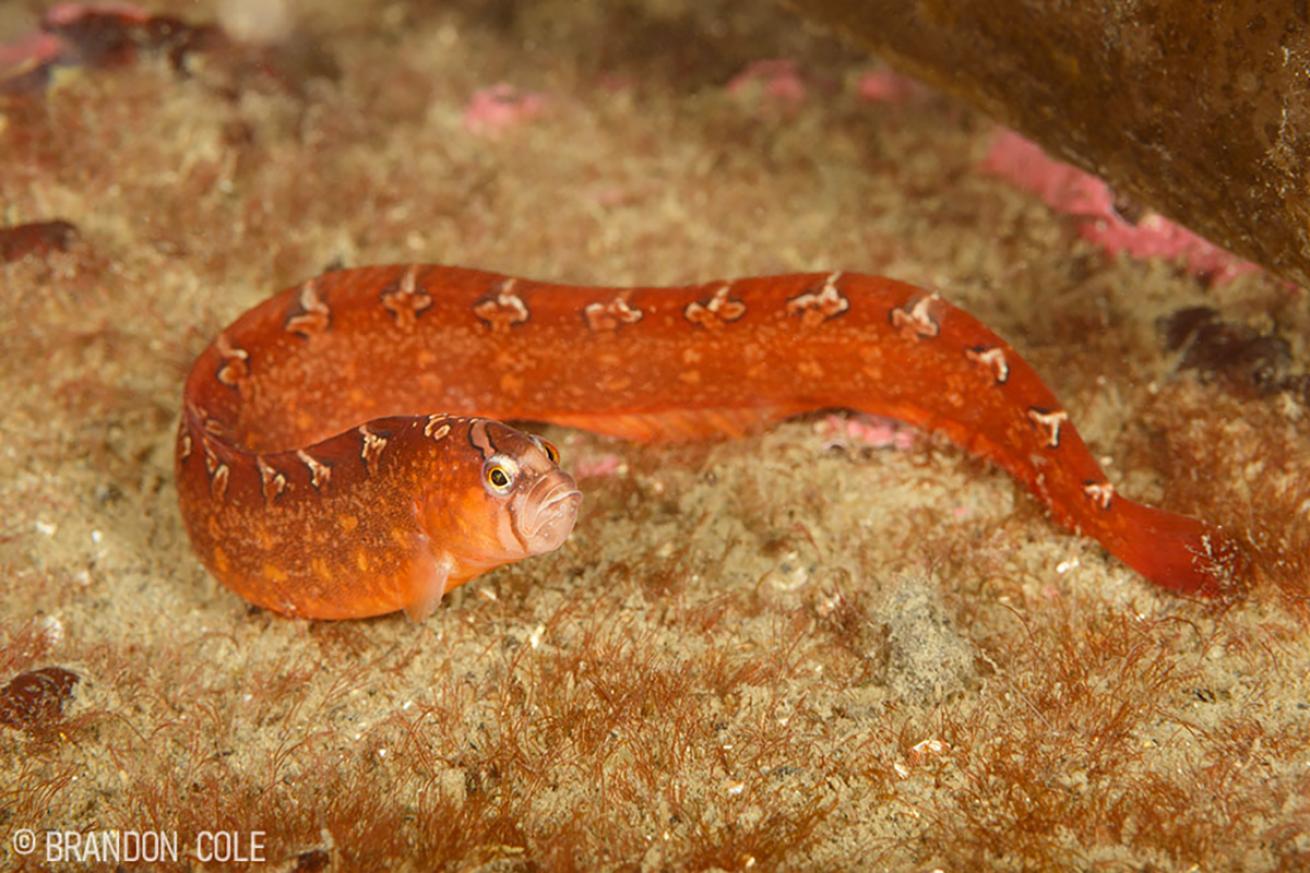
Brandon Cole4 inch long eel-like fish, which lives between from Alaska to northern California, rests in Ogden Point.
At the southern end of 300-mile-long Vancouver Island is the Breakwater at Ogden Point. It’s perhaps the most popular dive in the Victoria area, accessible from shore and enjoyable even when currents are cranking elsewhere. The reef is comprised of stone blocks stair-stepping down to over 60 feet. I usually go full macro mode here as the cast of characters in residence is impressive: longfin and scalyhead sculpins, gobies, gunnels, numerous nudibranch species, brittle stars, hermit crabs, and shrimp, just for starters. Many of these animals are tucked back in the nooks and crannies or hiding amongst clumps of algae, so go slow, get low and use a spotting light if necessary during your critter hunt. Short (35 or 40mm), medium (50 or 60mm), or long (100 or 105mm) macro lenses will all serve you well.
This is also a great spot to use a flip-down or screw-on wet diopter to increase lens magnification to twice-life size or beyond. The Breakwater’s solid substrate offers a stable platform for focus-critical super macro work, so push the limit on your closeups. Intimate fish faces, crustacean eyeball shots, otherworldly abstracts and beautiful patterns are just a few of the creative possibilities.
Renate Reef, Barkley Sound
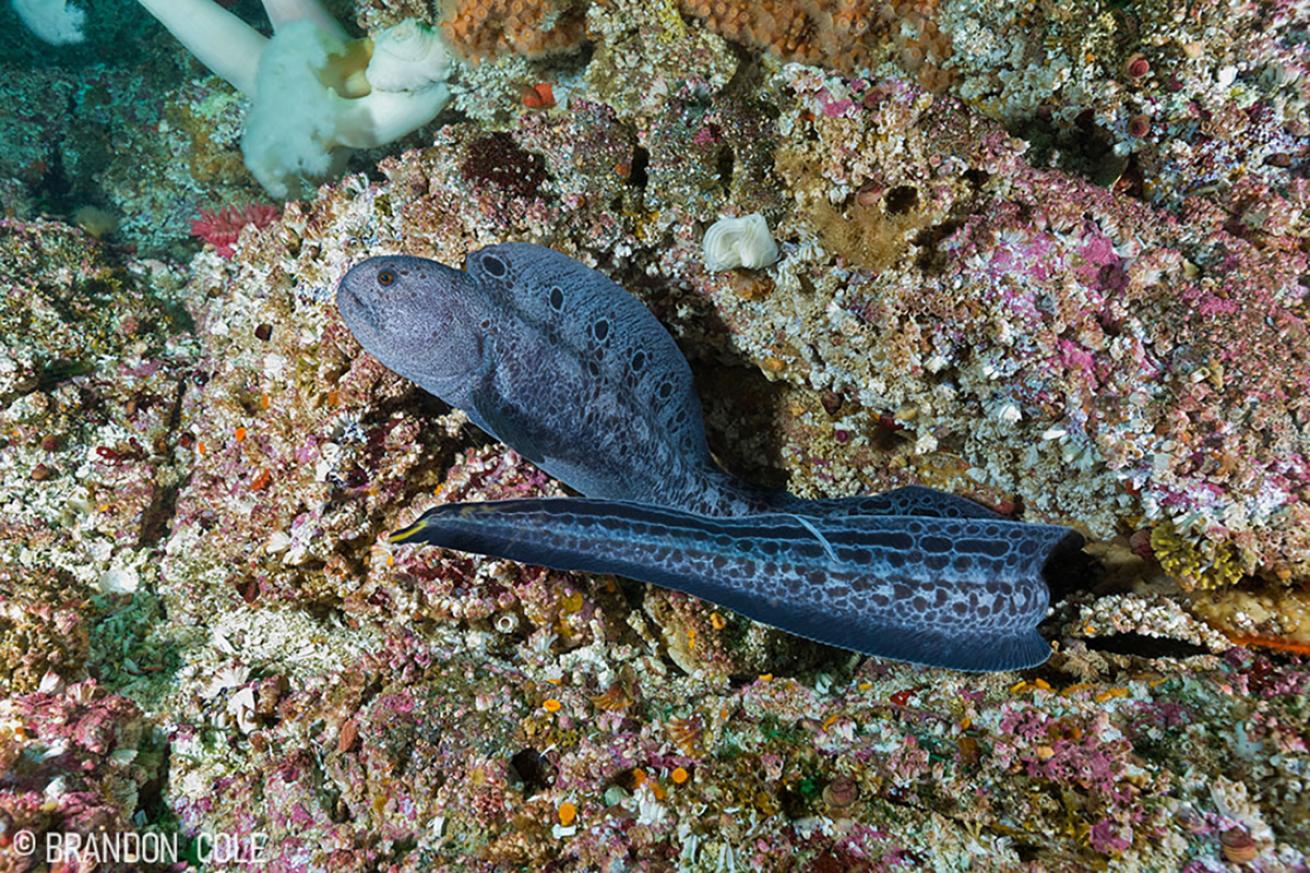
Brandon ColeThe Wolf eel is among the tapestry of bustling life at Renate Reef.
Moving west to Vancouver Island’s exposed outer coast takes you to another SCUBA hotspot. Barkley Sound boasts dozens of remote dive sites, many with a look subtly different than the inner coast. Photographers with keen interest in species identification will appreciate an ecological community that includes certain plants and animals more commonly found in northern California. Giant kelp, for example, tops some of the pinnacles in Barkley Sound, sharing space with bull kelp which dominates on Vancouver Island’s eastern flank. Also on the bonus species list are certain invertebrates such as bryozoans and molluscs, and of course fish. Renate Reef is a Swiss Army knife of a dive site where I mix both macro and wide angle pursuits.
The seamount is home to all creatures great and small including octopus, wolf eels, giant jellyfish, ling cods, mosshead warbonnets, rose spotted anemones, purple-ringed topsnails, and rockfish. Loads of rockfish. In fact, on one recent dive I counted nine different species of Sebastes, and tasked myself with capturing at least one image of each. I chose a super versatile 17-70 zoom lens for maximum flexibility with regards to perspective. Highlights of my personal photography challenge were hovering in the middle of a cloud of one hundred-plus yellowtail rockfish and playing hide and seek with curious-slash-reclusive tiger rockfish. China and copper rockfish were relatively easy to photograph. I managed environmental portraits of these beauties lounging about on the reef by using the lens near its wide end, then reframed and zoomed in for tighter head shots. Patience in waiting for my subjects to acclimate to my presence and then show interest in me (or my camera!) allowed me to bag some very nice keepers with fins flared and strong eye contact. I love improving my fish whisperer skills at Renate Reef.
Madrona Point, Nanoose Bay
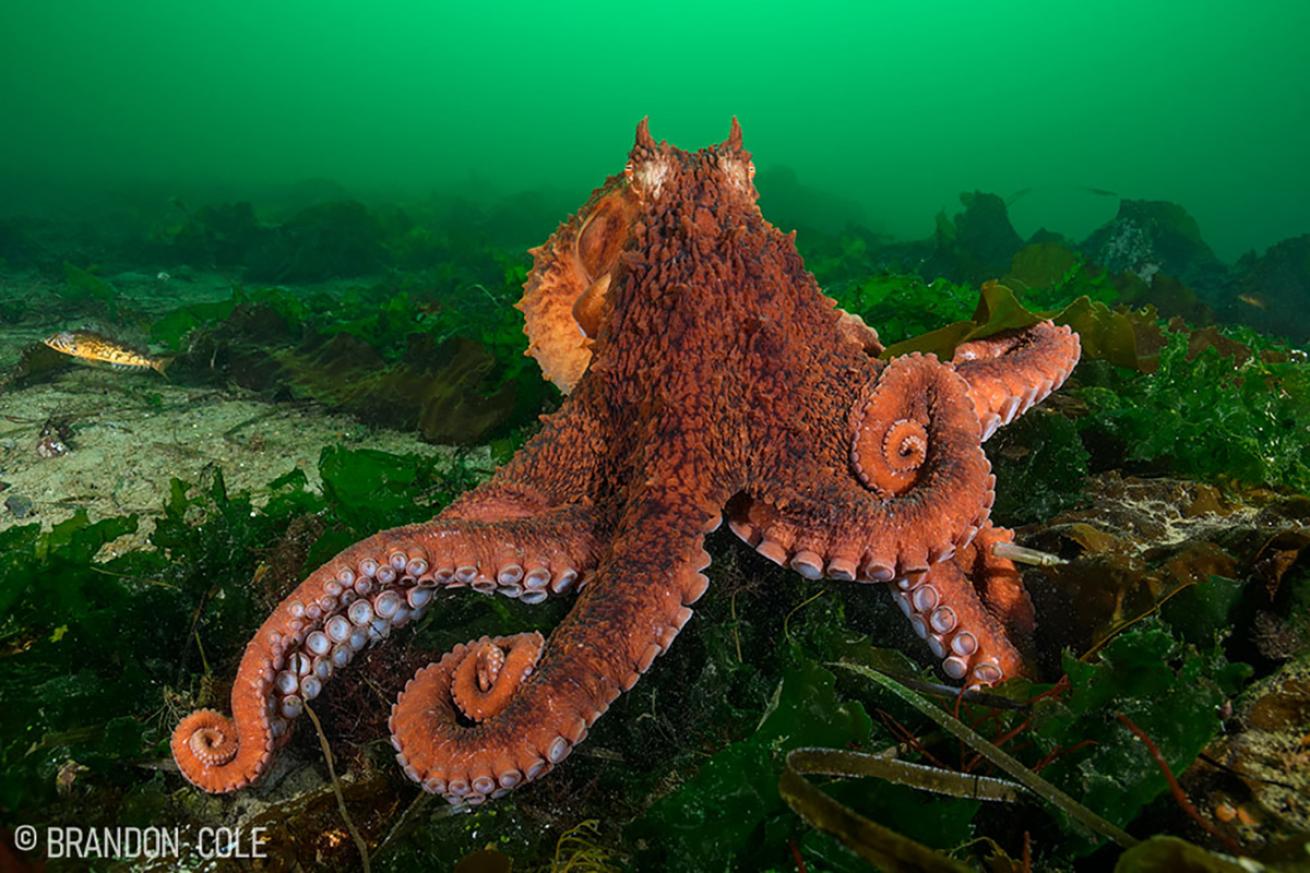
Brandon ColeA Giant Pacific Octopus moves along the seabed.
Luck, and the latest, greatest camera gear, are sometimes cited as reasons for why a person succeeded in taking a great underwater picture. Personally, I believe that competence with one’s gear (whether new or old, high-tech or low), lots of time in the water, and knowledge of the subject and the environment in which it lives are all more important ingredients in the photographic equation. Understanding the significance of the latter drives many serious shooters to research their quarry and plan the dive ahead of time.
When I first started diving the Pacific Northwest decades ago I asked experienced locals where I could see Giant Pacific Octopus (GPO). More than a few folks suggested Madrona Point, a short drive north of the city of Nanaimo on Vancouver Island’s sheltered, eastern side. This is most definitely GPO country. It’s not uncommon to see at least a few octos along the rock wall 60 and 100 feet deep that runs east-west and is a five to 10-minute swim from shore. Most encounters are actually sightings of the krakens wedged back into cracks and not necessarily killer photo opps. (An artful tangle of suckered tentacles, however, or the beast’s cool slitted eye, can make an excellent closeup shot.) But if you dive here often enough, by day and by night, sooner or later you will encounter a GPO out of its den, the holy grail for cephalopod fans like yours truly.
The octo might be hiding in plain sight, motionless and cunningly cryptic against the rock, or it might be crawling up or down the wall. It could also be out in the open in the sand at the wall’s base, snacking on a crab, or gliding through its shadowy realm like an alien hovercraft. Sometimes they are curious, even bold enough to grab you with their surprisingly strong, rubbery arms; other times they are skittish and retreat to the security of their lair. If only we could climb into the unfathomable mind of this most enigmatic, charismatic life form to better understand its mysterious moods.
A wide angle zoom lens (e.g., a 16-35mm on full frame DSLRs, and a 10-24mm or Tokina 10-17mm on cropped sensor DSLRs) is a sound choice to accommodate the wide size range of GPOs. I prefer to use two strobes fired in manual mode, adjusting their output as needed to provide just enough fill flash to balance an exposure metered for the ambient light level in the background, or more power to illuminate a darker scene against sand, rock or algae.
HMCS Saskatchewan, Nanaimo
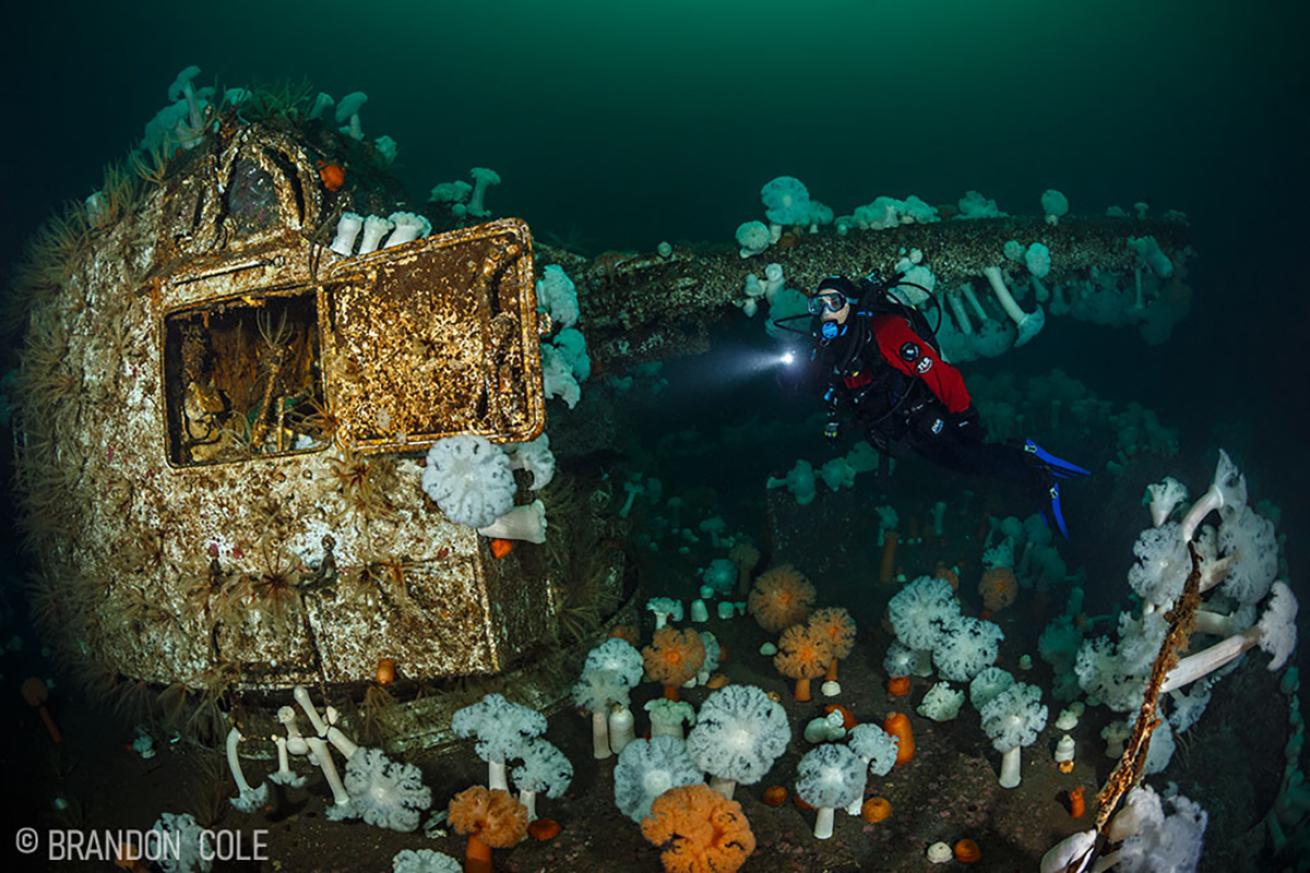
Brandon ColeA diver explores the submerged remains of the HMCS Saskatchewan.
Battleships are undeniably big, high value targets. The Saskatchewan, a 366-foot-long Mackenzie-class destroyer escort, began its new mission as a magnet for marine life and divers when the Artificial Reef Society of British Columbia (ARSBC) sank it on June 14, 1997 off Nanaimo harbor in 130 feet of water. I was there in the flotilla of photojournalists on that momentous day and I have returned many times since to document what I consider to be the most photogenic of ARSBC’s fleet of eight purpose-sunk ships and one airplane.
Lady Saskatchewan looks better each time I descend to pay my respects and fire away with my cameras. Use your widest lens—the 180 degree full-frame fisheye optic is ideal—for the expansive scene of the imposing forward deck guns down at 90 feet deep. Swim inside the bridge to compose a dramatic picture from the ship’s command center looking out. And be sure to save enough air to work the stunning radar tower in 45-50 feet at the end of the dive. The entire ship is decorated with white and orange plumose sea anemones, standing at attention like spectral soldiers. The Saskatchewan is like a multi-tiered wedding cake, Metridium whipped frosting glowing in the green gloom.
Incorporating another diver in your wreck pictures will convey the spirit of exploration and discovery. Brainstorm with your buddy and strategize a plan before submerging. Discuss details including navigation and shot locations, model position and movement, shooting angles and lighting options, and of course underwater hand signals and safety protocols. Make notes and diagrams on a slate. All of this preparation and communication will pay off, adding polish to your portfolio.










